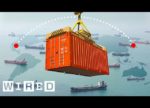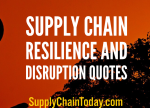What is Return and Reverse Logistics?
Returns (reverse logistics) are a common part of the supply chain process, and there are several key aspects of managing returns that are involved in supply chain management. These include:
- Return policy: A return policy is a set of guidelines that outlines the terms and conditions under which a customer can return a product. This may include information such as the time frame in which a return can be made, the types of products that are eligible for return, and the process for obtaining a refund or replacement.
- Return handling: Return handling involves managing the process of receiving and processing returned products. This may include activities such as inspecting the returned product, determining whether it is eligible for a refund or replacement, and issuing a refund or processing a replacement.
- Reverse logistics: Reverse logistics involves coordinating the movement of returned products from the customer back to the company or a third-party provider. This may involve using various transportation modes and coordinating the handling and storage of the returned product.
- Refunds and credits: Refunds and credits involve issuing a refund or credit to the customer for the returned product. This may involve processing the refund or credit through the company’s payment system or issuing a physical check or credit card credit.
- Product disposal: Product disposal involves disposing of returned products that are no longer suitable for sale or that cannot be resold. This may include activities such as recycling or donating the product, or disposing of it in an environmentally responsible manner.
Return logistics is the process of returning products or materials to their original point of manufacture or distribution for the purpose of disposal, repair, or refurbishment. This process typically involves the coordination of transportation, handling, and processing of returned goods.
There are several reasons why products may be returned, including defects, damages, or simply because the customer has changed their mind. In many cases, products that are returned are either repaired and resold or recycled.
Reverse logistics, on the other hand, refers to the broader process of managing the return of products or materials from the end of their useful life back through the supply chain network. This process includes the collection, transport, and processing of returned goods, as well as the coordination of any necessary repairs or refurbishment.
Reverse logistics is an important part of a sustainable supply chain, as it helps to reduce waste and minimize the environmental impact of products. It is often closely linked with initiatives such as recycling and refurbishment programs, which can help to extend the useful life of products and reduce the overall demand for new resources.
Advantages and Disadvantages
There are several advantages to implementing effective return and reverse logistics processes in a supply chain:
- Cost savings: By returning products for repair or refurbishment instead of disposing of them, companies can save on the cost of replacing those products with new ones.
- Improved customer satisfaction: Returning products for repair or replacement can improve customer satisfaction by addressing any issues or problems that customers may have experienced with those products.
- Reduced waste: Returning products for repair or refurbishment rather than disposing of them can help to reduce the overall amount of waste generated by the supply chain.
- Increased sustainability: Implementing effective reverse logistics processes can help to extend the useful life of products, which can reduce the demand for new resources and help to reduce the environmental impact of the supply chain.
There are also some potential disadvantages to consider when implementing return and reverse logistics processes:
- Increased complexity: Managing the return of products or materials can add additional complexity to the supply chain, which can be challenging to coordinate.
- Increased costs: While there may be cost savings associated with repairing or refurbishing products instead of replacing them, there may be additional costs associated with managing the return process itself.
- Risk of product damage: There is a risk of products being damaged during the return process, which can result in additional costs or reduced customer satisfaction.
- Limited control: Companies may have limited control over the condition of returned products, which can make it difficult to accurately assess their value and determine the most appropriate course of action.
Cost Savings
One of the main advantages of implementing effective return and reverse logistics processes in a supply chain is cost savings. By returning products for repair or refurbishment instead of disposing of them, companies can save on the cost of replacing those products with new ones.
For example, if a company sells a product that is prone to defects, it may be more cost-effective to repair or refurbish those products rather than replacing them with new ones. This can help to reduce the overall cost of goods sold for the company and improve its profitability.
Similarly, by implementing effective reverse logistics processes, companies can extend the useful life of products and reduce the overall demand for new resources. This can help to lower production costs and improve the overall efficiency of the supply chain.
Overall, effective return and reverse logistics can help to reduce waste, improve customer satisfaction, and lower costs, making it an important consideration for companies looking to optimize their supply chain operations.
Supply Chain and Logistics Information
- Amazon Robotic Revolution.Amazon Robotic Revolution. Amazon is at the forefront of a robotic revolution in its fulfillment centers. Here’s a glimpse into what’s going on: The Rise of the Machines: Robots on …
- Atlas vs Optimus: Boston Dynamics & Tesla’s Humanoid Robots.Atlas vs Optimus: Boston Dynamics & Tesla’s Humanoid Robots. Atlas and Optimus are two of the most well-known humanoid robots in development today. Here’s a breakdown of each: Atlas Optimus …
Atlas vs Optimus: Boston Dynamics & Tesla’s Humanoid Robots. Read More »
- Every Stop a Shipping Container Makes from China to ChicagoEvery Stop a Shipping Container Makes from China to Chicago Without the invention of shipping containers many of the efficiencies in logistics would be lost. Shipping Container from China to …
Every Stop a Shipping Container Makes from China to Chicago Read More »
- Supply Chain Resilience and Disruption Quotes by Top Minds.Supply Chain Resilience and Disruption Quotes by Top Minds. Supply Chain Resilience and Disruption Resources Facebook Comments
- Supply Chain Disruption: Mississippi River Flood and Labor Strikes.Supply Chain Disruption: Mississippi River Flood and Labor Strikes. Are you prepared if there is a supply chain disruption caused by a Mississippi River flood with labor strikes? This confluence …
Supply Chain Disruption: Mississippi River Flood and Labor Strikes. Read More »
- Walmart’s CEO Rise to the Top – Doug McMillonWalmart’s CEO Rise to the Top – Doug McMillon Doug McMillon was born in Bentonville, Arkansas, in 1966. He began his career at Walmart as a summer associate in 1984, …
- Kaizen (Continuous Improvement): Secret behind Japanese ProductivityKaizen (Continuous Improvement): Secret behind Japanese Productivity. This is a great video to watch how Kaizen (continuous improvement) is used to increase productivity. Is this a video that can help …
Kaizen (Continuous Improvement): Secret behind Japanese Productivity Read More »
- Sourcing and Procurement in Supply Chain Management.Sourcing and Procurement in Supply Chain Management. Sourcing and procurement are two important aspects of supply chain management. Sourcing involves identifying and selecting suppliers, while procurement involves ordering and receiving …
Sourcing and Procurement in Supply Chain Management. Read More »







